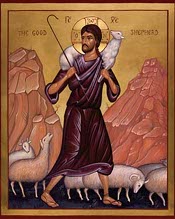This mass will be live streamed on YouTube.
Here is the program.

Mount Calvary Church
A Roman Catholic Parish
The Personal Ordinariate of the Chair of St. Peter
Baltimore, Maryland
Rev. Albert Scharbach, Pastor
Dr. Allen Buskirk, Choir Director and Cantor
Midori Tanaka, Organist
May 3, 2020
10 A.M. Livecast on YouTube
Easter IV
Good Shepherd Sunday
___________________
Common
Missa de S. Maria Magdalena, H. Willan
___________________
Anthems
Psalm 23, Herbert Howells (1892-1983)
The Lord is my shepherd;
therefore can I lack nothing.
He shall feed me in a green pasture
and lead me forth beside the waters of comfort.
He shall convert my soul and bring me forth in
the paths of righteousness, for his name’s sake.
Yea, though I walk in the valley of the shadow
of death, I will fear no evil,
thy rod and thy staff comfort me.
Thou shalt prepare a table before me
against them that trouble me;
thou hast anointed my head with oil,
and my cup shall be full.
But thy lovingkindness and mercy shall follow me
all the days of my life,
and I will dwell in the house of the Lord for ever.
This setting of Psalm 23 is from the larger composition Requiem. Although written in 1936, Requiem was not released for performance until 1980, held back by Howells following the death of his son Michael in 1935. Michael contracted polio during an epidemic and died three days later. It is a harmonious and deeply Romantic composition, but restrained and it is at these moments we realise how affected he was by his loss.
_________
Beati quorum via, Charles Villiers Stanford (1852-1924)
Beati quorum via integra est, qui ambulant in lege Domini.
Blessed are the undefiled in the way, who walk in the law of the Lord.
Beati quorum via (Psalm 119: 1) is a restrained, pastoral prayer. Stanford’s instrumental treatment is manifested in the skilful sonata structure whose two contrasting thematic subjects are defined by the opening words (‘Beati quorum via’) and the secondary phrase (‘qui ambulant in lege Domini’). Both ideas, in the recapitulation, are subsequently reworked with consummate legerdemain.
___________________
Hymns
The King of love my shepherd is (ST COLUMBA) was written by Sir Henry Williams Baker (1821–1877). It is notable for its skillful meter, and its well-managed rhyme scheme of single and double rhymes, which control and shape the emotion very beautifully. Baker gave an Anglican slant to Psalm 23, interpreting it as a psalm of love and care, but stressing these qualities as evidenced in the Eucharist. The spread table of verse 5 becomes the altar on which the elements are displayed, and the delight comes as the believer takes the ‘pure chalice’; the unction, or anointing (from 1 John 2: 27), while bestowing grace in a spiritual sense, also has suggestions of a rite. This verse spreads its meaning through the whole hymn, allowing the words of Psalm 23 to acquire an extra significance: so that the last verse suggests that the length of days of a person’s life can be spent, figuratively, ‘within thy house for ever’, in the service and under the influence of the church, and then later in heaven. The singer can reflect back, and conclude that the first verses suggest the ransomed soul, sought out in love and rescued from sin (Baker’s version of ‘he restoreth my soul’). The beautiful use of the shepherd metaphor in verse 3, as the shepherd carries the lamb gently on his shoulder, is an illustration of the tenderness of Baker’s work: these lines were the last words spoken by Baker on his deathbed.
Baker’s name is chiefly known as the promoter and editor of ‘Hymns Ancient and Modern,’ first published in 1861. To this collection Baker contributed many original hymns, besides several translations of Latin hymns. In 1868 an ‘Appendix’ to the collection was issued, and in 1875 the work was thoroughly revised. The hymnal was compiled to meet the wants of churchmen of all schools, but strong objections were raised in many quarters to Sir Henry Baker’s own hymn addressed to the Virgin Mary, ‘Shall we not love thee. Mother dear?’
Sir Henry Baker held the doctrine of the celibacy of the clergy, and at his death the baronetcy devolved on a kinsman.
Because the compilers of the 1906
English Hymnal were denied permission to use Dykes’s original tune DOMINUS REGIT ME, musical editor Ralph Vaughan Williams (1872-1958) turned to a folk tune that his former teacher Charles Villiers Stanford (1852-1924) had recently edited for a collection of Irish music (
A Complete Collection of Irish Music as noted by George Petri (London, 1902-1905). The two most notable improvements Vaughan Williams made in the hymn tune known as ST. COLUMBA (Here is Willan’s
Prelude) were the lengthening of the second and fourth lines to extend the Common Meter tune to 8787 in order to accommodate Baker’s text—this being their first appearance together—and the use of a triplet (rather than an eighth and two sixteenths) in the sixth measure. The 3/4 Irish melody reinforces the experiential, affective, and narrative elements of the text and accentuates the iambic stresses of the text.
_________
I know that my redeemer lives (DUKE ST) is by the English Baptist Samuel Medley (1738-1799). The hymn uses a simple repetition of “He lives” to celebrate the resurrected Jesus who rules our lives and gives us eternal life.
DUKE STREET is by John Warrington Hatton (1710 -1793) was christened in Warrington, Lancashire, England. He supposedly lived on Duke Street in Lancashire, from where his famous tune name comes. Very little is known about Hatton, but he was most likely a Presbyterian, and the story goes that he was killed in a stagecoach accident.
